|
|
|
Sort Order |
|
|
|
Items / Page
|
|
|
|
|
|
|
| Srl | Item |
| 1 |
ID:
127871


|
|
|
|
|
| Publication |
2014.
|
| Summary/Abstract |
In order to meet its 2050 target of 80% carbon emissions reduction, the UK is facing a challenge of restructuring its energy system, possibly by introducing more decentralised energy (DE) systems.Following semi-structured interviews, four exemplar international cases have been critiqued in order to investigate the variety and interrelationship of the drivers and barriers involved during their implementation, and then compared with the barriers and drivers that can potentially affect the implementation of similar projects in the UK context. The impacts of the barriers on the outcomes of these projects were evaluated, and recommendations were presented on overcoming these barriers if replicating similar projects in the UK context. Governance drivers play the most significant role, whereas financial drivers (commonly believed to be crucial), are deemed to play a lesser role. Social, governance and financial barriers rather than technological barriers constitute the central problem areas for the increased adoption of DE. The drivers and barriers experienced in the international cases were similar to those anticipated in the UK. The case studies present a high potential for replication and scaling up in the UK context and demonstrate that the increased implementation of DE systems could also enhance social and governance benefits.
|
|
|
|
|
|
|
|
|
|
|
|
|
|
|
|
| 2 |
ID:
127160


|
|
|
|
|
| Publication |
2014.
|
| Summary/Abstract |
Among natural gas producing nations, there has been some concern about how the Asia Pacific will meet future demand for energy. We argue that natural gas, both regional and global, will play a vital role. Estimates of potential gas consumption in the region are analyzed and used to develop consensus projections to 2030. These consumption profiles are compared with gas supply estimates including indigenous, pipeline and LNG for the Asia Pacific market. From this analytical framework, we find that demand will be sufficiently large to accommodate supplies from diverse sources including North America, the Middle East, Central Asia, Russia, and the Asia Pacific itself. An important policy implication is that gas producing and consuming nations should benefit from promoting gas trade and not be concerned about a situation of potential lack of demand coupled with oversupply.
|
|
|
|
|
|
|
|
|
|
|
|
|
|
|
|
| 3 |
ID:
127283
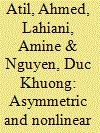

|
|
|
|
|
| Publication |
2014.
|
| Summary/Abstract |
In this article, we use the recently developed nonlinear autoregressive distributed lags (NARDL) model to examine the pass-through of crude oil prices into gasoline and natural gas prices. Our approach allows us to simultaneously test the short- and long-run nonlinearities through positive and negative partial sum decompositions of the predetermined explanatory variables. It also offers the possibility to quantify the respective responses of gasoline and natural gas prices to positive and negative oil price shocks from the asymmetric dynamic multipliers. The obtained results indicate that oil prices affect gasoline prices and natural gas prices in an asymmetric and nonlinear manner, but the price transmission mechanism is not the same. Important policy implications can be learned from the empirical findings.
|
|
|
|
|
|
|
|
|
|
|
|
|
|
|
|
| 4 |
ID:
128396


|
|
|
|
|
| Publication |
2014.
|
| Summary/Abstract |
When Brazil opened up its huge offshore petroleum discoveries to foreign developers in October, after holding off on a decision for six years, government leaks indicated that Chinese state oil companies would dominate the bidding for the estimated reserve of eight to twelve billion barrels of oil. When the bids were opened, however, the Chinese proved to be far more cautious than expected and took only a minority participation in the winning consortium dominated by Petrobras, the Brazilian state oil company, and two major Western multinationals, Royal Dutch Shell, the Anglo-Dutch giant, and Total, the largest French oil company.
|
|
|
|
|
|
|
|
|
|
|
|
|
|
|
|
| 5 |
ID:
127279
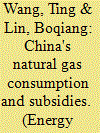

|
|
|
|
|
| Publication |
2014.
|
| Summary/Abstract |
China's natural gas consumption is growing rapidly and it has being driven by economic growth, industrialization and urbanization. In addition, the country's low-carbon development strategy, government-controlled gas price, and some other factors also contribute to the surging gas consumption. This paper studies China's natural gas consumption in residential, industrial and commercial sectors. We adopt the cointegration test and error correction model to study the relationships of explanatory factors and gas consumption of different sectors and climate factor is included into the analysis. In order to find the direction of natural gas pricing reform and establish the benchmark gas price, this paper also estimates the size of gas price subsidy by using price-gap approach. Our findings are as follows: In the long term, China's residential sector is more sensitive to price than the other two. Urbanization is an important factor promoting industrial and commercial gas consumption. Prices of other energies have an influence on natural gas consumption significantly due to the substitutability between energies. The slow-moving and unsatisfying pricing reforms on refined oil and natural gas lead to positive price elasticity of natural gas in the commercial sector, which implies that a further energy price reform is still stringent for China.
|
|
|
|
|
|
|
|
|
|
|
|
|
|
|
|
| 6 |
ID:
127902
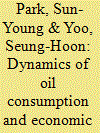

|
|
|
|
|
| Publication |
2014.
|
| Summary/Abstract |
This study attemps to investiagte the causal relationship between oil consumption and economic growth in Malaysia where oil consumption and real gross domestic product have been rapidly increased in recent years. To this end, the study employs annual data covering the period 1965-2011. Tests for unit roots, co-integration, and Granger-causality based on the error-correction models are presented. The overall results support the existence of bi-directional causality between oil consumption and economic growth in Malaysia. This means that an increase in oil consumption directly affect economic growth. Thus, in order not to make an adverse effect on economic growth, Malaysia should endeavor to overcome the constraints on oil consumption. Moreover, it appears that economic growth induces oil consumption
|
|
|
|
|
|
|
|
|
|
|
|
|
|
|
|
| 7 |
ID:
126565
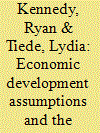

|
|
|
|
|
| Publication |
2013.
|
| Summary/Abstract |
Scholars have argued that oil resources lead to poor quality institutions and governance, which causes slower economic growth, an increased propensity for civil war, and other maladies. Such conclusions, however, rest on strong modernization assumptions that oil resources are unrelated or detrimental to the level of economic development. Utilizing a unique multilevel version of extreme bounds analysis (EBA), we find that oil's deleterious effects on governance are not well established. Instead, when we relax strong assumptions about the exogeneity of economic development and utilize more objective indicators of institutional quality, oil has a net positive impact on governance. Moreover, when accounting for endogeneity, there is little to suggest either an intervening or independent effect of poor governance on civil conflict in petro-states.
|
|
|
|
|
|
|
|
|
|
|
|
|
|
|
|
| 8 |
ID:
127996
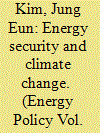

|
|
|
|
|
| Publication |
2014.
|
| Summary/Abstract |
Fast growing global energy needs raise concerns on energy supply security and climate change. Although policies addressing the two issues sometimes benefit one at the expense of the other, technology innovation, especially in alternative energy, provides a win-win solution to tackle both issues. This paper examines the effect of oil endowment on the patterns of technology innovation in the transportation sector, attempting to identify drivers of technology innovation in alternative energy. The analysis employs panel data constructed from patent data on five different types of automobile-related technologies from 1990 to 2002: oil extraction, petroleum refining, fuel cells, electric and hybrid vehicles (EHV) and vehicle energy efficiency. I find that countries with larger oil endowments perform less innovation on refining and alternative technologies. Conversely, higher gasoline prices positively impact the patent counts of alternative technologies and energy efficiency technology. The findings highlight the challenges and importance of policy designs in international climate change agreements.
|
|
|
|
|
|
|
|
|
|
|
|
|
|
|
|
| 9 |
ID:
127163
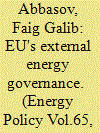

|
|
|
|
|
| Publication |
2014.
|
| Summary/Abstract |
The major objective of this paper is to apply a multidimensional lens to the European Union's (EU's) vision to the yet to be establish Southern Gas Corridor. I will argue that, the EU's natural gas vision towards the Caspian basin is based not only on bringing additional gas volumes to the EU markets in order to ensure physical security of supply. It is rather multidimensional external governance geared, firstly, towards absorbing all the actors along the whole value chain in to the EU's common energy regulatory framework and shifting energy provision from a bilateral political domain onto a multilateral market domain. Secondly, it is a process of diffusion of norms and values into the governance system of the energy partners
|
|
|
|
|
|
|
|
|
|
|
|
|
|
|
|
| 10 |
ID:
127280


|
|
Financial analysis on the proposed renewable heat incentive for: a case study on the solar thermal system
/ Bakar, Siti Hawa Abu; Sukki, Firdaus Muhammad; Iniguez, Roberto Ramirez; Munir, Abu Bakar, Yasin, Siti Hajar Mohd, Mallick, Tapas Kumar, McLennan, Campbell, Rahim, Ruzairi Abdul
|

|
|
|
|
| Publication |
2014.
|
| Summary/Abstract |
This short communication paper focuses on the renewable heat incentive (RHI) scheme in the United Kingdom (UK); and in particular, on its implication on domestic installations of solar thermal systems (STSs). First, a short review on the STS in the UK is provided. Then, a detailed description of the RHI is discussed. A financial analysis is presented afterwards, analysing the impact of the RHI scheme on the applicants, in terms of the net present value and the internal rate of return. From the financial analysis it has been found that the RHI scheme for domestic installations is only attractive if a longer period of RHI payment, i.e. 17 years, or a higher RHI rate i.e. £0.32 per kW h is implemented. The current proposal from the UK government is not financially viable, and as a result, it may hinder the penetration of domestic solar thermal systems in the residential sector in the UK.
|
|
|
|
|
|
|
|
|
|
|
|
|
|
|
|
| 11 |
ID:
127273


|
|
|
|
|
| Publication |
2014.
|
| Summary/Abstract |
As government and industry plan to reduce energy consumption in building stock, there is a need to forecast the uptake of retrofit packages across building stock over time. To address this challenge a diffusion model was set up and applied to office building stock across New South Wales (NSW) in Australia, accommodating a high spatial resolution and temporal capability for projecting uptake of technology packages characterised by multiple variables. Six retrofit packages were set up for the diffusion model, which ranged from inexpensive services and manuals through to mid-priced packages involving energy efficient T5 lighting and solar hot water through to expensive packages such as chilled beams and Solar PV. We evaluated the model using a base case and two policy programs, representing the Green Building Fund and Environmental Upgrade Agreements. These were recent incentive programs funded by the Australian government to accelerate the uptake of retrofit packages, by providing financial support to upfront expenditures and removing barriers to retrofit. By forecasting uptake of each retrofit package to 2032 under each program, we demonstrate how the model can be a valuable resource in tailoring expensive government programs and increasing their effectiveness.
|
|
|
|
|
|
|
|
|
|
|
|
|
|
|
|
| 12 |
ID:
127194


|
|
|
|
|
| Publication |
2014.
|
| Summary/Abstract |
The recent push to develop unconventional sources of oil and gas both in the U.S. and abroad via hydraulic fracturing ("fracking") has generated a great deal of controversy. Effectively engaging stakeholders and setting appropriate policies requires insights into current public perceptions of this issue. Using a nationally representative U.S. sample (N=1061), we examine public perceptions of hydraulic fracturing including: "top of mind" associations; familiarity with the issue; levels of support/opposition; and predictors of such judgments. Similar to findings on other emerging technologies, our results suggest limited familiarity with the process and its potential impacts and considerable uncertainty about whether to support it. Multiple regression analysis (r2=.49) finds that women, those holding egalitarian worldviews, those who read newspapers more than once a week, those more familiar with hydraulic fracturing, and those who associate the process with environmental impacts are more likely to oppose fracking. In contrast, people more likely to support fracking tend to be older, hold a bachelor's degree or higher, politically conservative, watch TV news more than once a week, and associate the process with positive economic or energy supply outcomes. Based on these findings, we discuss recommendations for future research, risk communication, and energy policy.
|
|
|
|
|
|
|
|
|
|
|
|
|
|
|
|
| 13 |
ID:
127267


|
|
Heat roadmap Europe: combining district heating with heat savings to decarbonise the EU energy system
/ Connolly, D; Lund, H; Mathiesen, B.V; Werner, S, Möller, B, Persson, U, Boermans, T, Trier, D, Ostergaard, PA, Nielsen, S
|

|
|
|
|
| Publication |
2014.
|
| Summary/Abstract |
Six different strategies have recently been proposed for the European Union (EU) energy system in the European Commission's report, Energy Roadmap 2050. The objective for these strategies is to identify how the EU can reach its target of an 80% reduction in annual greenhouse gas emissions in 2050 compared to 1990 levels. None of these scenarios involve the large-scale implementation of district heating, but instead they focus on the electrification of the heating sector (primarily using heat pumps) and/or the large-scale implementation of electricity and heat savings. In this paper, the potential for district heating in the EU between now and 2050 is identified, based on extensive and detailed mapping of the EU heat demand and various supply options. Subsequently, a new 'district heating plus heat savings' scenario is technically and economically assessed from an energy systems perspective. The results indicate that with district heating, the EU energy system will be able to achieve the same reductions in primary energy supply and carbon dioxide emissions as the existing alternatives proposed. However, with district heating these goals can be achieved at a lower cost, with heating and cooling costs reduced by approximately 15%.
|
|
|
|
|
|
|
|
|
|
|
|
|
|
|
|
| 14 |
ID:
127868
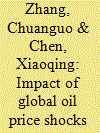

|
|
|
|
|
| Publication |
2014.
|
| Summary/Abstract |
This paper investigated the reaction of aggregate commodity market to oil price shocks and also explored the effects of oil price shocks on China's fundamental industries: metals, petrochemicals, grains and oilfats. We separated the volatilities of oil price into expected, unexpected and negatively expected categories to identify how oil prices influence bulk commodity markets. We contrasted the results between different periods and among classified indices, in order to discover the significant changes in recent years and the differences at an industry level. Our results indicate that the aggregate commodity market was affected by both expected and unexpected oil price volatilities in China. The impact of unexpected oil price volatilities became more complex after 2007. The metals and grains indices did not significantly respond to the expected volatility in oil prices, in contrast to the petrochemicals and oilfats indices. These results not only contribute to advancing the existing literature, but also merit particular attention from policy makers and market investors in China.
|
|
|
|
|
|
|
|
|
|
|
|
|
|
|
|
| 15 |
ID:
127884
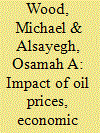

|
|
|
|
|
| Publication |
2014.
|
| Summary/Abstract |
This paper describes the influences of oil revenue and government's policies toward economic developments and energy efficiency on the electricity and water demands. A Kuwait-specific electricity and water demand model was developed based on historic data of oil income, gross domestic product (GDP), population and electric load and water demand over the past twelve years (1998-2010). Moreover, the model took into account the future mega projects, annual new connected loads and expected application of energy conservation programs. It was run under six circumstances representing the combinations of three oil income scenarios and two government action policies toward economic diversification and energy conservation. The first government policy is the status quo with respect to economic diversification and applying energy conservation programs. The second policy scenario is the proactive strategy of raising the production of the non-oil sector revenue and enforcing legislations toward energy demand side management and conservation. In the upcoming 20 years, the average rates of change of the electric load and water demand increase are 0.13 GW and 3.0 MIGD, respectively, per US dollar oil price increase. Moreover, through proactive policy, the rates of average load and water demand decrease are 0.13 GW and 2.9 MIGD per year, respectively.
|
|
|
|
|
|
|
|
|
|
|
|
|
|
|
|
| 16 |
ID:
127275
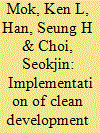

|
|
|
|
|
| Publication |
2014.
|
| Summary/Abstract |
Greenhouse gas emissions due to human activities are the main contributors to global climate change, a problem that should not be ignored. Through the clean development mechanism (CDM) introduced under the Kyoto Protocol, developing countries are able to earn certified emission reduction (CER) credits through a myriad of emission reduction projects. This study aims to explore the potential of implementing CDM projects in the construction and built environment (C&BE) industry, which has been criticized for not only consuming an enormous amount of resources, but also for contributing to adverse environmental health. In this research, we limit the boundary of the C&BE industry to include the planning, procurement, construction, occupation and refurbishment/demolition phases of a project's life cycle. Surveys and in-depth follow-up interviews with experts have generated useful insights pertaining to CDM potential and its adaptation into the C&BE industry. From this foundation, this paper evaluates the current obstacles to CDM and presents feasible suggestions to increase CDM projects related to the C&BE industry.
|
|
|
|
|
|
|
|
|
|
|
|
|
|
|
|
| 17 |
ID:
130867
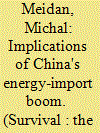

|
|
|
|
|
| Publication |
2014.
|
| Summary/Abstract |
Ensuring access to foreign oil has lost its dominance in Beijing's energy-policy debates. Ensuring access to ever larger quantities of foreign oil has been a focus of debate in China since the late 1990s, when the country's growing oil-import dependence became an inescapable reality. Research institutes and advisers to the Chinese leadership had been preoccupied with identifying the risks associated with China's foreign-oil supplies and devising policies to mitigate them. Yet, as the debate unfolded, it became clear that securing oil supplies was only part of the problem. The overall balance of energy supply and demand, the impact of state-controlled pricing and administrative intervention on the domestic market, and the weakness of institutions governing the energy industry came to be seen as problems that were equally, if not more, pressing. Between 2000 and 2004, a series of events highlighted various aspects of China's energy insecurity and, combined with a change of leadership in Beijing, ultimately led to a shift in energy-policy choices.
|
|
|
|
|
|
|
|
|
|
|
|
|
|
|
|
| 18 |
ID:
127269


|
|
|
|
|
| Publication |
2014.
|
| Summary/Abstract |
Hourly demand response tariffs with the intention of reducing or shifting loads during peak demand hours are being intensively discussed among policy-makers, researchers and executives of future electricity systems. Demand response rates have still low customer acceptance, apparently because the consumption habits requires stronger incentive to change than any proposed financial incentive. An hourly CO2 intensity signal could give customers an extra environmental motivation to shift or reduce loads during peak hours, as it would enable co-optimisation of electricity consumption costs and carbon emissions reductions. In this study, we calculated the hourly dynamic CO2 signal and applied the calculation to hourly electricity market data in Great Britain, Ontario and Sweden. This provided a novel understanding of the relationships between hourly electricity generation mix composition, electricity price and electricity mix CO2 intensity. Load shifts from high-price hours resulted in carbon emission reductions for electricity generation mixes where price and CO2 intensity were positively correlated. The reduction can be further improved if the shift is optimised using both price and CO2 intensity. The analysis also indicated that an hourly CO2 intensity signal can help avoid carbon emissions increases for mixes with a negative correlation between electricity price and CO2 Intensity.
|
|
|
|
|
|
|
|
|
|
|
|
|
|
|
|
| 19 |
ID:
127282


|
|
|
|
|
| Publication |
2014.
|
| Summary/Abstract |
Plug-In Electric Vehicles (PEVs) provide an opportunity for reducing energy use and emissions in the transportation sector. Currently, a number of federal policies are in place to incentivize deployment of PEVs to mainstream consumers with demographics and vehicle attribute preferences most common to today's new vehicle purchasers. This article argues that policies intending to give PEVs a foothold in the market should not focus on mainstream consumers and should instead focus on niche markets-specifically carsharing and postal fleets-and early adopters including green consumers. Two arguments can be made in support of eliminating the mainstream market bias of current policies toward a policy of cultivating niche markets. The first is efficiency: so far PEV policies featuring a mainstream market bias have proven to be inefficient and costly. The second is effectiveness: it is becoming increasingly evident that PEV policies would be more effective in achieving potential societal benefits if they focused on early adopters and niche markets using such approaches as strategic niche management, accessible loans and financing, and appropriately targeted incentives. PEV policies focused on early adopters and niche markets would create complementary system effects that will lead to increased PEV market penetration and realization of intended societal benefits.
|
|
|
|
|
|
|
|
|
|
|
|
|
|
|
|
| 20 |
ID:
127190


|
|
|
|
|
| Publication |
2014.
|
| Summary/Abstract |
After 40 years of oil investments, the UK is now a mature oil province. During these 40 years or so, the UK Government has changed the type of governance it uses to manage its petroleum resources. This paper introduces the theoretical background to two models of mineral resource governance: proprietorial and non-proprietorial regimes. It investigates how adoption any of these two models by the UK Government has historically affected the achievement of the objectives of the UK petroleum fiscal regime. The analysis tracks the changes in the governance of the UK petroleum resources using changes in the average petroleum tax rate, and how this last influenced the achievement of the objectives of the UK petroleum Regime. The findings remain significant for their policy implications. The study concludes that the UK Government adopted a proprietorial type of mineral governance during the period 1975-1982, before changing to a non-proprietorial regime in the period 1983-2000. Since 2000 it has begun to move back towards a proprietorial style of governance. The excessive use of one type of these modes of governance leads to the objectives of the UK petroleum fiscal regime being not met.
|
|
|
|
|
|
|
|
|
|
|
|
|
|
|
|
|
|
|
|
|